Braille-8 Unified Braille Unicode System
Braille-8 Unicode System is a comprehensive unified system providing a detailed mapping of 8-dot braille Unicode pattern to represent the transcribing codes (in English or any other language) as well as the math, science, and computer symbols/characters — mostly with one braille cell itself. Braille-8, through enhancement to the existing 6-dot Braille, aims to ease scientific learning for the visually challenged students. Braille-8 has already been presented in the IEEE Conference in 2016 and is already in public domain.
Efforts are on to provide the scientific learning benefits of Braille-8 to the Indian Braille users, with mapping of the complete 6-dot Bharati Braille (a unified braille script for the 10 major Indic languages) to Bharati Braille-8 – the Indic languages include Devanagari/Hindi, Bengali, Gujarati, Gurumukhi/Punjabi, Tamil, Telugu, Kannada, Malayalam, Oriya, and Urdu.
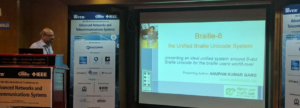
Present Braille Systems and Issues
Present Braille Systems and Issues
Traditional Braille code is based on a 6-dot (3 rows x 2 columns) pattern called ‘cell’. Unfortunately, it can represent, with each braille cell, maximum 64 unique symbols (including ‘space’ symbol). This is grossly insufficient to represent vast range of Maths and Science notation.
Since, with 64 symbols limitation, one can’t do justice with all types of needs anyway, multiple braille systems had been devised for catering to different reading/writing needs.
The Classic Braille had focused on optimizing braille for writing language texts mainly.
-
- For English, it provided one-cell pattern to 26 small letters and 14 basic punctuations only. Apart from that, in order to facilitate writing of language texts, it provided 48 contractions defining shorthand sequence. However, to achieve this with 64 symbol limitation, it re-maps most of the letters, as well as some of the punctuations based on the context. Unfortunately, this made braille reading/writing extremely context-dependent and thus, ambiguous.
- There were 10 indicators or modes – each acting either as the prefix to a multi-cell representation of other symbols or for setting up a mode (number-indicator, caps-indicator, symbol indicator, etc.) to indicate alternate-representations of the cell sequence following it. Consequently, one needs multiple braille cells to write one symbol.
- For example, even a simple algebraic identity 3A + 5B = 12C , that has 9 characters, takes 17 braille cells to write it.

- However, the mapping assignments were made primarily with ‘tactile readers’ in mind – hence, it gained instant acceptance from blinds.
There are primarily two unified braille codes that are mostly used world-wide
-
- Unified English Braille (UEB) – It derives itself from Classic Braille, but enhances it by providing braille cell sequence (of 4 cells, in some cases) to represent each Maths and Science notation. The main issue is while writing algebraic expressions, since numbers are re-mapped over alphabets in Classic Braille.
- Nemeth Uniform Braille System (NUBS) – It maps numbers differently than alphabets, hence does better in writing algebraic expressions. It also represents basic Maths and Science notation using braille cell sequence, but differently from UEB.
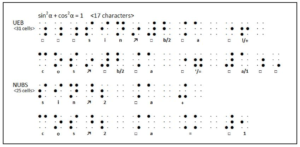
- Braille Computer Notation (BCN)
-
- Unicode Consortium defined Braille Unicode as an 8-dot code in range 2800 – 28FF. This allowed
 braille to represent up to 256 unique symbols with one-cell (4 rows x 2 columns) pattern.
braille to represent up to 256 unique symbols with one-cell (4 rows x 2 columns) pattern. - However, BCN defined one-cell mapping to its 95 ASCII characters only. Hence, it is still unable to do justice to Maths/Science transcribing. For example, one can’t write Sin2 θ + Cos2 θ or even H2SO4 in it, as there is no proper mapping for θ as well as for superscript/subscript.
- Unicode Consortium defined Braille Unicode as an 8-dot code in range 2800 – 28FF. This allowed
- BCN also completely let go off contractions/short-hands, hence couldn’t be used as a transcribing code or a Unified System. Moreover, its mapping has lots of mismatch with UEB as well as NUBS – thus, it demanded major “unlearning” from existing
 Braille users.
Braille users.
- Mainly used in “Refreshable Braille Displays”.
- Targeted for deaf-blind users.
-
The Design of Braille-8
Braille-8 System defines over the same Braille Unicode as an 8-dot code in range 2800 – 28FF, thus allowing Braille-8 to represent up to 256 unique symbols with one-cell (4 rows x 2 columns) pattern.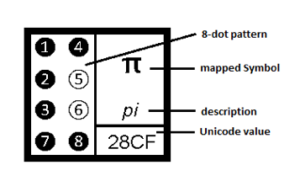
Palettes
Braille-8 divides 256 cell table into 4 Palettes of 64 cells each.

Palette-A (traditional 6-dot cell table having dot-7, 8 off)
Palette-A is mapped to UEB and classic braille.
Almost all constructs and assignments (excluding 23 alphabetic wordsign contractions) of UEB – represented with one-cell as well as with 2 or more cells – are supported here.
Thus Braille-8 becomes an extension of classic braille and UEB – there is no “unlearning” required from existing Braille users.
Palette-B (having dot-7 on)
Palette-B primarily includes the 26 capital letters (mapped similar to BCN) and 10 digits (by taking Nemeth’s shift-down mapping from Palette-A to Palette-B).
It also includes a few more symbols and indicators.
Palette-C (having dot-7, 8 on)
Palette-C primarily includes the 26 Greek symbols and trigonometric & logarithmic symbols, besides a few more symbols and indicators.
Palette-D (having dot-8 on)
Palette-D primarily includes the 23 UEB palette-A alphabetic wordsign contractions mapped to small letters and 17 most-used technical text wordsign contractions, besides a few more symbols and indicators.
Comprehensive Coverage
Braille-8 provides a comprehensive 8-dot mapping that caters to the needs of Math, Science, and Computer, as well as the Transcribing codes.
- 167 most-used symbols
- 26 small letters { a b c d e f g h I j k l m n o p q r s t u v w x y z }
- 26 capital letters { A B C D E F G H I J K L M N O P Q R S T U V W X Y Z }
- 10 digits { 1 2 3 4 5 6 7 8 9 0 }
- 33 punctuations and computer symbols { space , ; : . ! ? – ‘ & * + / % = $ @ ^ ~ “ ( ) { } [ ] < > # ` \ | _ }
- 26 Greek symbols { α β θ δ ε ϕ γ η ι χ κ λ μ ν ο π ∑ ρ σ τ υ Ω ξ ψ ζ }
- 14 basic math symbols { ÷ −(minus) ,000-separator ·(decimal) ≠ °(degree) dot-multiplier cross-multiplier proportional-with prime double-prime currency-major currency-minor Å }
- 10 trigonometrical, logarithmic, and calculus symbols { sin cos tan cot sec cosec arc- log ∂ Δ }
- 9 set theory & logic symbols { subset superset ᴜ ∩ ˄ ˅ ¬ ϵ ≡ }
- 5 geometry symbols { parallel, perpendicular, angle, triangle, quadrilateral }
- 8 formatting symbols { apostrophe, dash, soft-space, grouping-(, grouping-), soft-(, soft-), omission }
- 28 patterns in Palette-A to ensure compatibility and to avoid clash with UEB coding
- 21 patterns towards new indicators/prefixes
- superscript, subscript,
- start-radical, end-radical, start-radical-index,
- overlay-above, overlay-below, overlay-across, cancel-previous,
- end-subscript/superscript/radical-index/overlay,
- tally-mark-indicator, bullet-prefix,
- set-tactile-graphics-mode, set-braille-graphics-mode, set-math-mode, end-math/graphics-mode,
- set-language, set-currency, set-braille-code-system,
- <D71>, <D77>
- 40 patterns in Palette-D for word contractions
- 23 alphabetic wordsign contractions mapped in UEB
- 17 most-used technical text wordsign contractions
Benefits of Braille-8
Braille-8 has potential to be adopted as the new Braille standard for the braille users world-over.
Braille-8 is Compact
Braille-8 maps 167 most-used characters/symbols to one-cell braille – no need to place the corresponding indicators for representing them.
 Trigonometrical and logarithmic functions { sin cos tan cot sec cosec arc- log } are mapped to one-cell braille too, thus providing a shorthand-like representation for such functions.
Trigonometrical and logarithmic functions { sin cos tan cot sec cosec arc- log } are mapped to one-cell braille too, thus providing a shorthand-like representation for such functions.
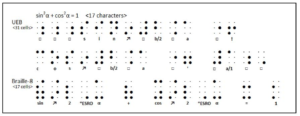
Braille-8 is Unambiguous
Braille-8 maps Wordsign contractions uniquely – no overlap mapping over alphabets and symbols.
Capital letters and Numbers too are mapped uniquely.
Moreover, Braille-8 provides well-designed nesting representation for subscript, superscript, and radicals – thus mapping unambiguously even complex constructs involving these.
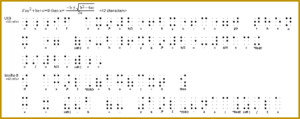
Braille-8 is easy for visually challenged users
Braille-8 has tried to provide Tactile based assignments to the maximum possible. For example, open and close brackets are mapped to those cells that they look like ‘brackets’ in tactile – moreover, each such pair is in mirror image.
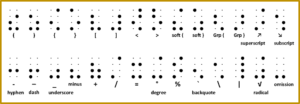 Similarly, Braille-8 has tried to provide Phonetic based assignments to the maximum possible as well. For example, all symbols that sound starting with ‘d’ are mapped in such a way that they get derived from the braille representation of ‘d’. It assists the visually challenged users in remembering them.
Similarly, Braille-8 has tried to provide Phonetic based assignments to the maximum possible as well. For example, all symbols that sound starting with ‘d’ are mapped in such a way that they get derived from the braille representation of ‘d’. It assists the visually challenged users in remembering them.

Braille-8 is a Unified System
Braille-8 is a Transcribing Code. It uniquely represents all letters and formats present in documents (both technical and non-technical) into braille sequence using mappings, as well as indicators and formatting constructs.
Braille-8 is Compatible
All constructs and assignments of UEB (except 23 alphabetic wordsign contractions) represented with one-cell as well as with 2 or more cells are supported in Braille-8.
The capital letters are mapped as per BCN coding, while the numeric digit mapping is derived by taking NUBS’s shift-down mapping to Palette-B.
Braille-8 is Internationalized & Localized
Braille-8 provides a separate generic symbol for currency-major and currency-minor. This frees the braille users from remembering the mapping for their corresponding currency symbols.
Similarly, it has a generic symbol for decimal and 000-separator that are locale specific too.
Since many countries use different languages but the same currency (e.g. European Union) and vice versa (e.g. English used in US, UK, Australia, India, etc.), Braille-8 provisions set-language and set-currency separately. In case, the user wishes to switch the language and/or currency in-between, these indicators may be used.
Furthermore, Braille-8 provides 111 language-specific cells, which may be used to map character-set and contractions for any other world language with one-cell only.
Braille-8 – the Way Forward
Braille-8 is a work-in-progress – a lot is yet to be done…
2-cell constructs of Braille-8
Braille-8 mapping has been defined for one-cell braille only. However, the additional symbols mapped with 2-cell constructs (using 10 UEB indicators and the 2 new Braille-8 indicators) needs to be defined too.
- Overlays/ Modifiers
- Bullets and Numbering
- Shapes and Arrows
- Tally marking
- Tactile Braille Graphics
- Web Address contractions
- Braille Code Setting Table
- Language Setting Table
- Currency Setting Table
Bharati Braille-8
I am presently working to map complete 6-dot Bharati Braille (a unified braille script for writing the following 10 Indic languages) to “Bharati Braille-8”:
- Devanagari / Hindi
- Bengali
- Gujarati
- Gurumukhi / Punjabi
- Kannada
- Malayalam
- Oriya
- Tamil
- Telugu
- Urdu
Braille-8 mapping for more world languages
Present mapping of Braille-8 is for English only. Future work would require Braille-8 mapping for many more world languages.
Language Processors
Braille-8 is designed such that it can be programmed from-print-to-braille and from-braille-to-print unambiguously.
Future work would include a language processor that converts MathML and LaTeX code to Braille-8 Unicode sequence. It would provide instant access of all the knowledge to the blinds what is available to the sighted.
Similarly, a language processor that parses and converts Braille-8 Unicode sequence to MathML and LaTeX code would give blinds an opportunity to share their thoughts and mind with the sighted.
Declaration: A portion of the content on this web page had been presented at IEEE Conference, Bengaluru 2016. You may find the full content of Braille-8 published in IEEE Xplore
